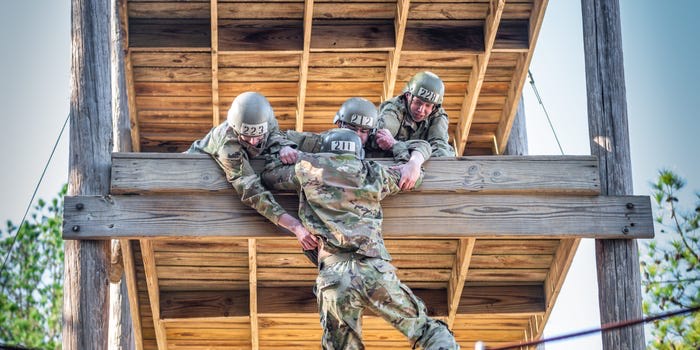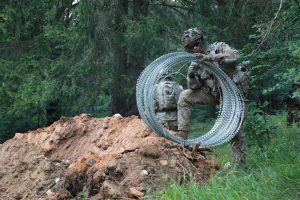CTLT: A Checklist for Cadet Success

Congratulations! You’ve earned the chance to spend 3-5 weeks with a unit doing CTLT. The experience will be informative and enjoyable if you make it so. This checklist will help you make the most of this incredible opportunity. It is by no means an all-inclusive list of things to do, but it should provide you a framework to keep you focused on the goal of this experience – improving your personal and professional development as a future Army officer!
Prior to Arrival
- T-4 to 6 Weeks. Reach out to your sponsor, typically the lieutenant you will be shadowing. Your Platoon Leader (PL) sponsor may not know they are receiving a Cadet – or that they are specifically receiving you. If you receive information on your assigned unit, you should send a concise, polite email to the unit S1 (personnel officer) and S3 (operations officer) briefly introducing yourself and asking for the contact information for the PL that will be sponsoring you. You can find contact information for the unit via internet searches, social media, or through your cadre (e.g., PMS, TAC officer, etc.)
- Once you establish contact with your PL sponsor, you can include more detail in your communication – you can politely ask what you can do to prepare in advance, ask for a training schedule, ask about any packing requirements, etc. You should draw gear from the Central Issue Facility (CIF) at the installation where you’re doing your CTLT but it’s good to ask about other requirements; perhaps there will be social events that require a more formal Cadet uniform or appropriate civilian attire. Hopefully, your sponsor will ask you about your goals and what you hope to learn during your CTLT experience; feel free to be honest with them as they may be able to better shape your experience if they know what you’re looking for.
- T-4 Weeks. Social media can be a powerful leadership tool, but it also comes with risks. There is a high probability that someone in the unit you are being assigned to will look you up on social media. You should consider reviewing some of your posts and ensuring that your online presence conveys a message you are comfortable with your subordinates and superiors viewing. If you want to keep it private, consider changing your security settings to prevent others from searching for you or seeing your content. You should be following good personal cyber security practices anyway!
- T-3 Weeks. Ensure you’ve engaged with your ROTC/USMA leadership about any administrative requirements that may still be pending. Is your Defense Travel System (DTS) authorization complete? Do you know what receipts you need to keep (e.g., anything over $75, hotels, etc.)? Ask these questions early so you are prepared and can work with your cadre to solve any problems that may arise. Leaders are proactive, not reactive.
- T-1 Week. Confirm your lodging plans (e.g., BOQ, hotel, etc.). Confirm arrival information and coordinate link-up with your LT/unit of assignment. Provide your sponsor your flight info, confirm any planning details you were provided in advance (e.g., packing list, any admin info you need to provide in advance, any training/reading you should do before arrival, etc.), and ask any final questions that you may have.
- T-5 Days. Ensure your DTS is approved and that your flights are booked. You will receive an email that is a confirmation, not just a tentative itinerary. Ensure you also have the SATO emergency number and the cell number of your LT/sponsor in case issues arise during your travels. Your flights should have confirmation codes that you can then check on the respective airline app. Speaking of apps, download the respective airline app as that is the best way to keep your boarding pass handy and receive other pertinent information from the airline. Pro-tip, most airlines waive baggage fees for military personnel with a CAC. Check with an airline agent at the airport for assistance checking bags. Don’t be afraid to ask!
During Your CTLT Experience
- Keep an open mind. Every chance to do “real Army stuff” is an opportunity to grow and learn regardless of which branch or component you are observing. Let your PL know if you have goals involving another branch and ask if they can help get you some exposure to that branch during any open time in your schedule.
- Ask questions. If your PL isn’t involving you, using jargon you don’t understand, or not spending time showing you how to do their job, ask them to explain or share! They are also learning as they go and might not know the answer. They might be overwhelmed with the workload and need some help in which case you should offer your assistance. You might offer suggestions on how you can get involved – help develop CONOPs, help with planning, supervise/lead vehicle inspections or any administrative tasks, maybe even lead an LPD on a topic (the Center for Junior Officers can help with that!). Some possible topics to discuss with your PL are:
- Training Management: reserving land, requesting ammo, running a range
- Maintenance: Preventative Maintenance Checks and Services (PMCS), dispatching vehicles, required paperwork
- NCO Evaluation Reports (NCOERs): rater and senior rater profiles, how to write bullets, what does/does not go in the evaluation
- Counseling: initial and quarterly, different formats, best practices
- Property Management and Inventories: what is a Sub-Hand Receipt, how to conduct an inventory, how to read a Technical Manual (TM), working with your XO and Supply NCO
- Physical Training (PT): platoon PT plans, training for the ACFT
- Platoon Equipment: how to use communication and weapon systems, arms room procedures, storage of property
Note – you can read / learn from LTs and CPTs about some of the above on the CJO website.
- Show up early to every scheduled event. Your PL may pick you up, you may have to use post transportation, or walk. You probably won’t be familiar with the area so plan on getting where you need to be early. Just DON’T BE LATE! Your future Soldiers are expected to be at the right place, at the right time, in the right uniform, with a good attitude. Lead by example and hold yourself to the same standard.
- Always have something to write on and with (not just your cell phone)
- You are joining the Profession of Arms, act like it. There may be appropriate occasions to enjoy a social drink of alcohol but use your judgment if you feel the situation is inappropriate (excessive drinking, fraternization between ranks, etc.). Many Cadets succumb to peer pressure and find themselves in inappropriate situations. When in doubt, politely excuse yourself and find your way back to your room.
- Engage with your peers. You may have open space on your schedule – you might be able to accompany some of your Cadet peers on training events (e.g., maybe a peer is serving in a unit of the branch you’re interested in, and you can spend some time shadowing them). Build and leverage your network. You will find yourself serving with these same Cadets in 12-24 months!
- Build relationships with the other officers and NCOs in the company. The NCOs in the platoon have had multiple PLs during their careers and will be more than willing to share best practices with you. Even if you are not interested in their technical or tactical expertise, learn from their leadership experiences. You’ll hear the good, the bad, and the ugly. All of those experiences will help mentally prepare you for the challenges of Army leadership.
- Ask to meet with the company and battalion command teams (the officer and the senior NCO). Prepare questions ahead of time such as: What do you look for in LTs in your unit? What are some common mistakes LTs make in your organization? What can I do now to prepare? You may not serve in their organization, but most command teams understand common trends shared throughout the officer corps. They’ll likely share personal vignettes and want to impart some lessons learned from their time in the Army.
- Daily Reflection: Take time each day to reflect on what you learned and observed. How you do this is entirely up to you; the important part is consistently writing and reflecting. You owe it to your professional development, and your future self, to take the time to record your thoughts. You’ll be surprised as you look back at how much you didn’t remember.
After Your CTLT Experience
- Within five days of returning from your CTLT location, file your DTS voucher. The system is straight forward but don’t hesitate to ask your cadre for assistance (they’ve done their fair share of DTS vouchers).
- Send a thank you note to your sponsor, the company commander, and the battalion commander. This simple act demonstrates professional maturity and will leave a lasting impact. Make sure to get a mailing address from the unit S1 prior to leaving.
- Maintain any connections you established that you found rewarding – this can be with Soldiers, NCOs, or officers. Make sure to keep your communication with them appropriate as you move forward but don’t be afraid to reach out if you have questions.
- You should bring any lessons you learned back to your ROTC program or cadet company. If you attended CTLT as a junior, maybe you can lead a presentation or Q&A session for cadets next year. Provide feedback to your chain of command on things that went well and those that didn’t.
- Consider codifying your reflections into an article about your experience. Find multiple editors (peers, professors, cadre, mentors) – and don’t be afraid to send them a rough draft. Writing can be intimidating. Do your best and your team will assist you through to the finish line. Consider submitting it to the Center for Junior Officers at CJO@westpoint.edu and feel free to include your recommended changes or additions to this checklist so the next generation of Cadets continue to maximize the incredible opportunities CTLT has to offer!
Related Posts

4 Essential Behaviors for Building Trust
Sincerity. Reliability. Competence. Care. No matter your role as a company-grade officer, trust is foundational to a team’s success. Trust connects a leader’s intent to …

Going Off Script, But Staying on Track: A Career Guide for Junior Leaders
Intro I walked into LTC Tomi King’s office as a new 2LT in his formation. We discussed all the normal talking points in that initial counseling – family, where I …

Fighting as an Enabler Leader
(U.S. Army Photo by Cpl. Tomarius Roberts, courtesy of DVIDS)Enablers provide capabilities to commanders that they either do not have on their own or do not have in sufficient quantity …
